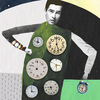
Darkish nights and lightweight days predict mortality, a brand new research finds.
Mar Lei/Getty Photographs
conceal caption
toggle caption
Mar Lei/Getty Photographs
Weight loss program, train, sleep — all are elementary to our well being, however our relationship to mild doesn’t get talked about as a lot. Now, a large new research suggests light-driven disruption can take years off our lives.
Scientists tracked practically 90,000 folks within the U.Okay. who spent every week with wrist-worn exercise units outfitted with mild sensors. Then, they analyzed their danger of dying over the subsequent eight years. The outcomes have been revealed within the Proceedings of the Nationwide Academies of Sciences.
The research members with the brightest nights had a 21% to 34% greater danger of untimely demise, in comparison with those that have been principally at nighttime between midnight and daybreak.
The other was true for daytime.
Individuals who loved the brightest days had a 17% to 34% decrease mortality danger than those that have been in dim environments throughout the daytime.
The information underscore that mild represents an “rising danger issue for poor well being and longevity,” says Daniel Windred, lead creator of the research and a postdoctoral researcher at Flinders College in Australia.
Earlier large-scale research have discovered related associations between mortality and lightweight publicity, for instance utilizing satellite tv for pc knowledge and self-reports. Nevertheless, the U.Okay research is the primary to straight measure private lighting environments across the clock.
“It is a very highly effective research,” says Dr. Charles Czeisler, chief of the Division of Sleep and Circadian Problems on the Brigham and Girls’s Hospital and Harvard Medical Faculty.
“We’re not speaking a couple of marginal change. We’re speaking about large will increase in danger related to an simply modifiable danger issue,” he says.
Whereas the research can solely present a correlation — not show causality — the “dose-dependent” response to mild was evident even when the researchers managed for components like socioeconomic benefit, earnings and bodily exercise.
The outcomes replicate many years of analysis indicating that our fashionable relationship to mild can spell catastrophe for our circadian rhythms — the patterns in our physiology and habits that fluctuate over the 24-hour cycle — influencing sleep, blood strain, how we use power, launch hormones and numerous different capabilities.
“We’re flooding the nighttime with mild that was by no means potential earlier than and shielding ourselves from mild throughout the day,” says Czeisler.
Listed below are 4 takeaways from the analysis.
Exterior mild is greatest
The advantages of getting shiny days have been constant from early within the morning to late within the afternoon.
Windred says it’s not exhausting to interpret the outcomes: They characterize individuals who have been spending time exterior in daylight.
“There is a huge bounce within the depth between an indoor and an outside setting,” he says.
We’re speaking orders of magnitude.
In a typical indoor setting, it’s possible you’ll be uncovered to about 100 to 500 lux (a unit of measurement for mild), in comparison with anyplace from 10,000 to over 100,000 lux relying on the circumstances and time of day. Even a cloudy day may be effectively over 1,000 lux.
The central circadian pacemaker in our mind is especially delicate to mild within the morning, and prioritizing mild at the moment could make you extra alert.
However even in the event you can’t pull that off, Windred says you’ll nonetheless reap the advantages of out of doors mild later within the day. “In the event you come dwelling from work within the afternoon and the solar is up, it is nonetheless a very good time to get mild.”
The truth is, Czeisler says folks are likely to underestimate the consequences of being exterior throughout daybreak and nightfall — instances when you find yourself being uncovered to completely different wavelengths and intensities of sunshine.
“We expect that these transitions are most likely notably vital,” he says. So long as there’s daylight although, he encourages folks to get open air, ideally for a minimum of half an hour to 45 minutes.
“It would not must be all of sudden,” he says, “It will do wonders for his or her well being.”
Search for the contrasts
You possibly can image circadian rhythms as undulating currents, with the ups and downs reflecting your physique’s modifications all through the dark-light cycle.
Digesting meals, repairing organs, replenishing the power in our brains and clearing out toxins, all of those operate higher if the circadian system resembles a strong wave.
And light-weight is probably the most highly effective cue. Throughout the day, it may possibly improve our rhythms — and at night time, suppress or shift their timing.
“The research is highlighting that you really want this distinction,” says Laura Fonken, a neuroscientist on the College of Texas at Austin, “It’s not nearly having too little mild throughout the day or an excessive amount of mild at night time.”
Put one other approach: You don’t need your day and night time lighting environments to be comparable. That may simply occur in the event you spend the majority of your days in an workplace, with out a lot pure lighting, she says.
The truth is, the U.Okay knowledge recommend the harms can add up if mild is inflicting your circadian rhythms to be misaligned on each fronts.
“We estimate that individuals with each shiny days and darkish nights might be dwelling as much as 5 years longer than folks with shiny nights and darkish days,” says Windred.
Mild may be protecting
Vivid days may set you up for a greater night — enhancing your sleep and shielding you in opposition to a number of the downsides of synthetic mild at night time.
“We all know that publicity to broad daylight throughout the day can truly scale back the sensitivity of our circadian system to mild publicity at night time,” says Windred.
Research measuring the impact of nighttime mild on the hormone melatonin, which promotes sleep, assist this idea: Examine members who spent their daytime in dimly lit circumstances had a lot larger melatonin suppression once they encountered mild at night time. That’s in comparison with those that have been uncovered to extra mild throughout the day.
Czeisler says this doesn’t imply you’ll be utterly impervious to the disruptive results of sunshine throughout the night, particularly the blue-enriched mild that’s emitted from our units.
“That sends a direct sign to the mind saying it is daytime,” he says.
Czeisler’s lab has documented that studying from light-emitting tablets within the hours earlier than you fall asleep can “shift your circadian rhythm, making it more durable so that you can go to sleep, harder so that you can get up and fewer possible that you’re going to go to mattress at an earlier hour the subsequent day.”
Hold lights out at nighttime
Individuals who had the bottom likelihood of dying within the coming years have been uncovered to barely any mild between about midnight and 6am, the research discovered.
Then again, shiny mild throughout the lifeless of night time — particularly between 2:30 and 3am — was related to the very best danger of mortality.
“That is an important time to keep away from mild,” he says, “It additionally occurs to be the time that the circadian system is probably the most delicate to mild.”
In latest many years, scientists have linked light-driven disturbances to all method of well being issues — weight problems, coronary heart illness, diabetes, most cancers, psychological sickness and different circumstances. Scientists have even proven that misalignment of circadian rhythms over comparatively brief intervals of time can mess with blood strain and the way the physique handles glucose.
The hazards of working the night time shift are well-documented, particularly for cardiovascular and metabolic well being.
On this newest research although, Czeisler factors out even when shift employees have been excluded from the evaluation, the detrimental results of shiny mild at 3 or 4 within the morning have been nonetheless “extremely vital.”
The very best time to show off the lights will rely, to some extent, in your schedule and chronotype — which is your physique’s pure preferences towards being extra of a morning or night particular person — says Fonken. However the backside line is straightforward: The stretch of time if you sleep ought to be as darkish as you may make it.
This story was edited by Jane Greenhalgh







